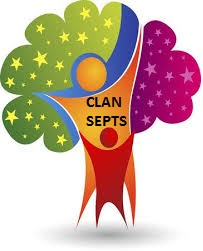
Septs are families that followed another family’s chief, or part of the extended family and that hold a different surname. It is known that research
reports of original Gaelic names being translated in English with various spellings. Some people also changed their family name at the time when they migrated to
another area of Scotland or to New World countries.
The Sept names can easily be seen to be either a direct conversion form Gaelic to English recognising the Mac was the Gaelic for son and Nic was the Gaelic for daughter. Niall could easily be converted to Neill or Neil, Neal, Neale and the many other variations of the above list of names. Other families changed their historic surnames at the time of migration to an easier pronounced English name.
The current list of Sept family names does not necessarily relate to the families who lived under the support of their clan chief in early years. These were the tenants and crofters who were protected by their chief but also asked to support him in times of conflict.
Records of surnames in the 16th century
The recording of family surnames commenced and many Gaelic names became Anglicised: transcription error during indexing;
misspelling, phonetic spelling or other misinterpretation by
registrars and clerks; deliberate or accidental misrepresentation by informants; surname variants; the family members may have altered their surname after emigration from Scotland, or anglicised the name on arrival in Scotland; and families from the Highlands and Western Isles may have anglicised their Gaelic surname, for
example, MacIan to Johnston.
There have been always leading families and the minor families. The history of the clan chief family of Barra shows their close association with the Clan MacLean and Clan MacLeod of Harris. In Argyll, the McNeills of Gigha and Taynish in early years had a close association with the Clan MacDonald of the Isles. After the MacDonalds lost the position of the Lord of the Isles, the McNeills of Gigha/Taynish and Colonsay built a close relationship with the Clan Campbell who
represented the Crown in Argyll.
